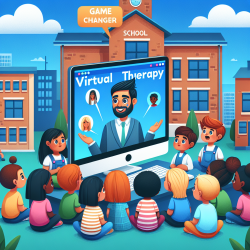As Speech-Language Pathologists (SLPs) working in schools, we are constantly navigating the ebb and flow of educational demands, technological advancements, and the diverse needs of our students. The quest for effective, innovative solutions to meet these challenges head-on has never been more pressing. In this spirit of exploration and growth, I want to talk about a significant shift that's reshaping the landscape of speech therapy: telepractice.
Telepractice, or the delivery of speech therapy services via online platforms, has emerged as a beacon of change, offering a myriad of benefits that align with our core mission—fostering communication skills in students to help them succeed in and out of the classroom. For those of you who are on the fence about this modality or curious about its impact, let's dive into the transformative power of telepractice and how it can inspire us as educators and clinicians.
The Dawn of Telepractice
Telepractice in speech therapy isn't a novel concept; it has been around for years, gaining momentum with each technological leap. However, recent global events have catapulted it from a supplementary option to a primary mode of service delivery for many. This shift has prompted a reevaluation of traditional therapy models, urging us to consider how we can leverage technology to enhance our practice.
At its core, telepractice is about accessibility. It breaks down geographical barriers, making it possible to connect with students in remote or underserved areas who would otherwise have limited access to speech therapy services. But its benefits extend far beyond logistics. Telepractice fosters a unique learning environment that can be highly engaging for students, especially those who are digital natives.
Building Connections in a Digital Age
One of the most remarkable aspects of telepractice is its ability to build and maintain connections. Initially, there might be concerns about the impersonal nature of online interactions. However, experience and numerous success stories have shown that strong, meaningful relationships can be forged through screens. With creativity and empathy, we can create a therapeutic space that feels personal, warm, and conducive to learning.
Moreover, telepractice offers flexibility in scheduling and environment that traditional settings often lack. This flexibility can lead to increased attendance and participation rates, as sessions can be more easily integrated into students' and families' busy lives. It also allows for therapy to be conducted in the student's natural environment, which can be less intimidating and more conducive to generalization of skills.
Embracing Technological Tools
Telepractice opens up a treasure trove of digital resources that can enrich our therapy sessions. Interactive games, apps, and online assessments can make learning not just effective but fun. These tools not only engage students but also provide us with real-time data to track progress and tailor our approaches more precisely to each student's needs.
Another advantage is the ease of collaboration telepractice facilitates. It's simpler to coordinate with teachers, parents, and other therapists to ensure a holistic approach to a student's development. This collaborative environment, supported by shared digital resources, can significantly enhance the impact of speech therapy.
Challenges and Opportunities
Adopting telepractice does come with its set of challenges. Concerns about technology access and equity, ensuring privacy and confidentiality, and mastering new tools and platforms are valid. However, these challenges also present opportunities for growth and innovation. They push us to think critically about how we can make our services more inclusive, secure, and effective.
Moreover, the shift towards telepractice encourages professional development and lifelong learning. Staying abreast of technological advancements and digital tools becomes part of our journey as SLPs, enriching our skill set and enabling us to offer the best possible support to our students.
The Future of Speech Therapy
As we look to the future, it's clear that telepractice will play a significant role in the evolution of speech therapy. Its potential to make therapy more accessible, engaging, and collaborative is undeniable. However, it's not about replacing traditional methods but rather enhancing and expanding our toolkit to meet the diverse needs of our students.
Embracing telepractice requires an open mind and a willingness to adapt. It's a journey that invites us to rethink how we connect, teach, and learn. As we navigate this path, let's draw inspiration from the successes and lessons learned thus far, and remain committed to innovation, excellence, and, most importantly, the progress of our students.
In closing, I encourage my fellow Speech-Language Pathologists to explore the possibilities that telepractice offers. Let's view it as an opportunity to grow, innovate, and ultimately, make a more profound impact on the lives of the students we serve. Together, we can embrace this change, harnessing the power of technology to open new doors for communication, learning, and connection.
Change is not just coming; it's here. And it's filled with potential. Let's seize it with both hands, inspired by the promise it holds for our profession and the students whose lives we are privileged to touch.










